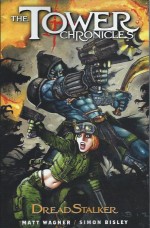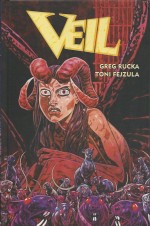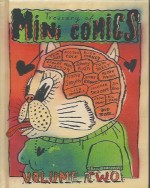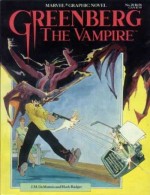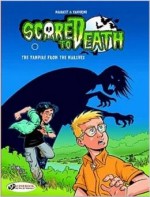
By Mark Millar, Robert Kirkman, Reginald Hudlin, Greg Land, Sean Phillips, Francis Portela, Mitch Breitweiser & various (Marvel)
ISBN: 978-0-7851-8538-3
Swiftly catching a cultural wave to become one of modern Marvel’s most popular niche-franchises, the canny blend of gratuitous measured sarcasm and arrant cosmic buffoonery compiled here traces all the early appearances of the deadly departed, flesh-eating superheroes from an alternate universe which wasn’t so different from the one we all know – at least until a dire contagion killed every ordinary mortal and infected every super-human upon it…
This mammoth volume re-presents the first appearances of those chompy champions as seen in Ultimate Fantastic Four #21-23 and #30-32, Marvel Zombies #1-5, Marvel Zombies: Dead Days #1 and Black Panther volume 4 #28-30 (plus material from Marvel Spotlight: Marvel Zombies/Mystic Arcana collectively spanning September 2005 to October 2007) and leaps into sinister high gear following Robert “The Zombie Guy†Kirkman’s informative introduction ‘Marvelous Zombies’…
In many ways a highly entertaining one-trick pony, these tales all depend on a deep familiarity with the regular Marvel pantheon, a fondness for schlock horror and the cherished tradition of superheroes beating the stuffings out of each other.
This time however, it’s for keeps, with beloved icons actually eating the stuffings out of each other – and just about everyone else – until only a handful of living breathing folk remain, desperately seeking a cure or a way to escape their universe without bringing the hunger plague with them…
It all begins with the first chronological appearance of the brain-eaters: a bleak and subtle exploit which appeared in Ultimate Fantastic Four #21-23. This team is a retooled version of the Lee/Kirby stalwarts created as part of the Marvel Ultimates imprint which began in 2000.
After Marvel’s near-demise in 1996, the new management oversaw a thoroughly modernising refit of key properties: fresher characters and concepts to appeal to a new generation of “ki-dults†– perceived to be a potentially separate buying public from those readers content to stick with the various efforts that had gradually devolved from the Founding Fathers of the House of Ideas.
This super-powered quartet are part of a corporate think-thank tasked with saving the world and making a profit, and in ‘Crossover’ by Mark Millar, Greg Land & Matt Ryan, wünderkind Reed Richards is contacted by a smarter, older version of himself offering the secrets of trans-dimensional travel.
Defying his bosses and comrades, Reed translates to the other Earth only to find he’s been duped by adult, zombie versions of the FF, looking for fresh fields to infect and people to digest…
Breaking free, young Richards discovers a devastated, desolate New York populated solely by manic monster superheroes, all eager to eat one of the last living beings on the planet. Suddenly rescued by Magneto, Reed meets other survivors as they prepare for their last hurrah. Offering them a chance to escape, Reed is blissfully unaware that he’s already allowed the Zombie FF to invade the still living world he came from…
Culminating in a bombastic battle on two planes of reality and a tragic heroic sacrifice, this creepy chronicle ends with the zombie FF imprisoned on Ultimate Earth…
The concept evolved into a franchise in February 2006 with the launch of 5-part miniseries Marvel Zombies, by Robert Kirkman & Sean Phillips, which returned to the infected alternate Earth to detail the final fall of humanity and the improbable things that happened next…
With the living all gone or infected, Earth’s former heroes and villains are at a loss. Fighting and bickering whiles away time but since nothing can kill them and only living flesh will sate their hunger for even a second, all hope seems lost until a strange glowing alien on a surfboard appears in the sky…
Unaware that Giant-Man has keeping a stash of live humans (including former friend Black Panther) to eat in secret and one piece at a time, the zombies are united by Colonel America and Iron Man into an army to capture and consume the cosmic skyrider.
As the living ruin who was the Panther escapes and fortuitously unites with Magneto’s remaining mutant acolytes, the Silver Surfer falls to a happily distracted army of zombies who devour him and somehow absorb his cosmic energies. But as they finish, the planetary devourer Galactus arrives, demanding to know where his herald is…
The star god eats entire planets to survive but even he has never encountered hunger such as possesses the zombies. Hundreds of the massed undead launch themselves at him and although he destroys many he cannot kill them all…
As Earth’s remaining human and mutants form an uneasy alliance and flee to a hidden sanctuary, Galactus readies himself to consume Earth but is unprepared for the ingenuity of the zombie Avengers who turn the tables and eat the eater.
Now the whole universe is at risk since Iron Man, Hulk, Luke Cage, Wolverine, Giant-Man and Spider-Man – fuelled by Galactus’ limitless cosmic energy – can travel from planet to planet to assuage their unceasing appetites…
Following a few tantalising snippets culled from intervening UFF issues with the undead quartet describing what they’ll do when – not if – they get loose, the saga finally explodes into high gear in ‘Frightful’ from Ultimate Fantastic Four #30-32, by Millar, Land, Ryan & Mitch Breitweiser.
Here the Ultimate Universe Dr. Doom enacts a subtle plan to crush his arch-rival Reed Richards, but the imprisoned, lab-rat zombie FF have their own agenda: one which includes escaping and eating every living thing on the planet…
A far more serious tale of revenge and obsession, this yarn is a real chiller in a volume far more silly than scary and culminates in an unlikely sacrifice to save the world from the one person nobody expected to give a damn……
Events take a lighter tone if not turn when events on the original Marvel Earth impinge on the zombieverse.
Here a Civil War had erupted between costumed heroes after the US government ordered all superhumans to unmask and register themselves. From that period comes ‘Good Eatin”, a light-hearted, grotesquely slapstick 3-part hoot from Black Panther #28-30 (July-October 2007).
The tale revealed how, on undead Earth, the six victorious zombies – Tony Stark, Luke Cage, Giant-Man, Spider-Man, Wolverine and the Hulk – ate Galactus and absorbed all his power. With every other food source exhausted they then ranged their entire reality for forty years, killing every thing and every person in every civilisation they could find.
Convened for a brief time as the “New Fantastic Four†of our Earth, X-Man Storm, Human Torch, Thing and the Panther went time- and dimension-hopping at just the wrong moment and ended upon a hidden citadel of the shape-shifting Skrulls just as the Galactal Zombie Diners Club discovers what just might be the last edible planet in their universe.
‘Hell of a Mess’, ‘From Bad to Worse’ and ‘Absolutely No Way to Win’ (by Reginald Hudlin & Francis Portela) comprise an action-packed, hilariously bad-taste splatter-fest to delight the thrill-seeking, grossness-engorged teenager in us all…
The story portion of this chronicle of the damned concludes with a one-shot prequel which concentrated on the tragedy of the final hours of that doomed alternity. In Marvel Zombies: Dead Days (May 2007), Robert Kirkman & Sean Phillips detailed exactly how humanity ended after Earth’s heroes all gathered to battle a super-villain from another dimension.
This intruder had unfortunately imported an extra-dimensional curse to this reality: one that turns the infected (for which read “bittenâ€) victims into ravenous, undead eating machines. Before a day was out a chain reaction of terror had devastated the world, leaving its costumed champions nothing more than the apex predators atop a rapidly diminishing food source…
This tome is as much art book as graphic narrative and also includes an incredible range of alternate and variant covers as well as a gallery of the landmark original covers used by zombie illustrator Arthur Suydam as the basis for the 50 new spoof and pastiche images he created: all referencing key moments from Marvel’s decades-long-history and adding so much to the project’s success.
These include Jack Kirby & Steve Ditko’s Amazing Fantasy #15 (from August 1962), Spider-Man #1 by Todd McFarlane (August 1990), Amazing Spider-Man #50 (July 1967 by John Romita Sr.), Hulk #1 by Kirby & Paul Reinman (May 1962), Avengers #4 (March 1964 by Kirby), Daredevil #179 (February 1988 by Frank Millar & Klaus Janson), X-Men #1 (September 1963, by Kirby & Sol Brodsky, Silver Surfer #1 (John Buscema, August 1968), Fantastic Four #1 (November 1961 by Kirby), Avengers #87 (April 1971 by John Buscema & John Verpoorten), the other X-Men #1 from October 1991 by Jim Lee & Scott Williams, Secret Wars #1 (May 1984, Mike Zeck & John Beatty) and so many more, all accompanied by the artist’s fascinating insights and commentary
As well as Suydam’s fiendish fifty reinterpretations there are 42 covers by Land, Matt, Frank D’Armata, Justin Ponsor, Jay Leisten, Phillips, Juan Bobillo, Kaare Andrews, David Aja, Leonard Kirk, Aaron Lopresti, Jeromy Cox, Carlo Pagulayan, Romita Sr., Ed McGuinness, Jason Keith, Richard Corben, Ariel Olivetti, David Yardin, Matt Milla, Scott Clark, Boris Vallejo, Earl Norem, Kyle Hotz and Dan Brown, all adding to the devilish dark art delights and augmenting the feature-packed prose section at the end.
Essays and snippets here include ‘Interview Excerpts from Marvel Spotlight: Robert Kirkman/Greg Land’, ‘A Gruesome Good Time: The Story of the Marvel Zombies’, ‘Whose Stomach Are You In?’, ‘Undead Again’ and ‘Life Among the Zombies’ – all by Dugan Trodglen – plus a picture-&-sketch packed expose of ‘The Crazy World of Arthur Suydam’ as explained to John Rhett Thomas, all adding to the comprehensive overbite overview of things ..
By no means to everyone’s taste, this blending of ferocious fangtastic fable with gross-out comedy mixes the sentiments of American Werewolf in London, the iconography of Shaun of the Dead and the cherished hagiography of the Marvel Universe to surprisingly engaging effect. Not for the squeamish or continuity-cherishing hardliners, there might be a loud laugh or frisson of fear awaiting the open-minded casual reader…
© 2005, 2006, 2007, 2013 Marvel Characters, Inc. All rights reserved.


